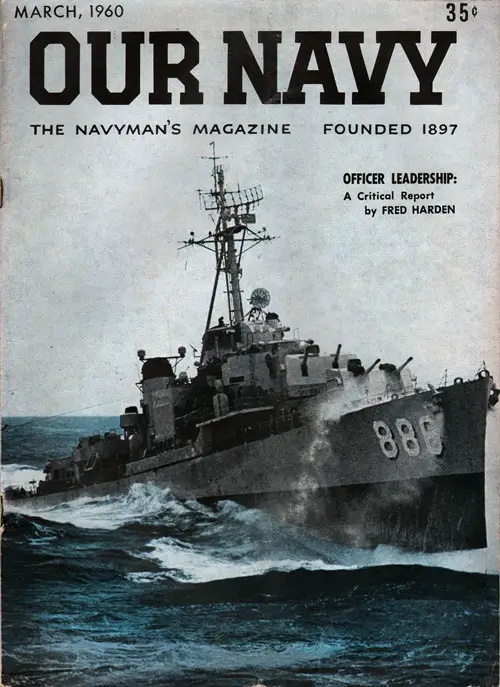Our Navy Magazine March 1960 "Playing War" Pays Off

OUR NAVY
March 1960
Vol. 55 No. 3
The Navy Man's Magazine Founded 1897
On the Cover: A highline transfer when the weather is like this calls for the very best in seamanship. Photo, taken from the Yorktown, shows the destroyer Orleck (DD-886), with her bow tossed clear of the sea.
CONTENTS
- Inside Our Navy 2
- Officer Leadership: Its Diseases and Cures 3
- USS Canberra (CAG-2) 6
- Pacific Fleet's Guided Missile Submarines 8
- "Playing War" Pays Off 10
- The Philadelphia Naval Base 11
- Bronson's Hard Hat (Part I) 13
- Master of Miles and Millimeters -- Faster, Safer Cat Shots 16
- Atlantic Report 17
- Pacific Report 25
- A Lot of Work, A Lot of Danger, A Little Glory 32
- Washington Briefs 34
- Pentagon Report 35
- Inland Report 41
- Sports Report 42
- Movie Report 44
- Car Report 46
- Crossword Puzzle 53
- Salt Shakers 58
- Contacts and Swaps 59
- The Wind in The Rigging 61
- Editorial 64
All photographs are official Department of Defense or Our Navy photos unless otherwise credited. All opinions are those of the editors or contributors, and are not necessarily the official views of the Navy Department or the U. S. Government.
Entire contents copyrighted, 1960, by OUR NAVY, Inc.
Publisher's Letter
IF THERE IS ONE THING a publisher likes to receive, it is letters from readers. This is true even if the letters include a percentage of complaints. Most publishers appreciate the occasional complaints for this is one way they learn to give their readers what they want.
One complaint that seems to be consistently present is, "You have so much advertising there is no room for reading material." We wish we had it so good. The costs of printing and selling a publication like OUR NAVY are much more than the cover price you pay. To make up the difference, magazines must accept advertising. Each publication sets its own policies. Trade journals accept up to 49% advertising. Some go as far as 75%. OUR NAVY, keeping to our policy of giving Navymen an honest deal, has a 25% maximum.
Then, there is the type and quality of advertising that a publisher will accept. Here again his policy dictates what is acceptable. We screen every potential advertiser and quite often we have refused space to some, for no publisher would want to be caught dead with a report such as was recently published by the DAVISVILLE YARDARM (newspaper of the Atlantic Seabee Center):
"A Seebee was interested in a car he saw advertised in a weekly paper which has wide circulation among Navy people. He phoned the dealer in Washington, D. C., and was told that the car, one year old and priced at $995, was in good running condition. He hurried to Washington by plane and saw the car. It was s'aved in on one side from being sideswiped, radio and heater had been removed, and wornoVal.ires and seat cushions had been substituted for the ones that came with the car."
The article didn't say how many cars the Seebee bought, nor did it say just what choice words he used. We do know that most large manufacturers add to the costs of their manufactured products by spending millions for advertising. Why? Because they know that they can get more customers by making them aware of their consistant quality, correct selling price, and money back guarantees if it does not meet all advertising specifications.
Beware of the guy who advertises he is giving away his merchandise. It costs money to advertise—so the advertiser will give you nothing for nothing.
OUR NAVY
